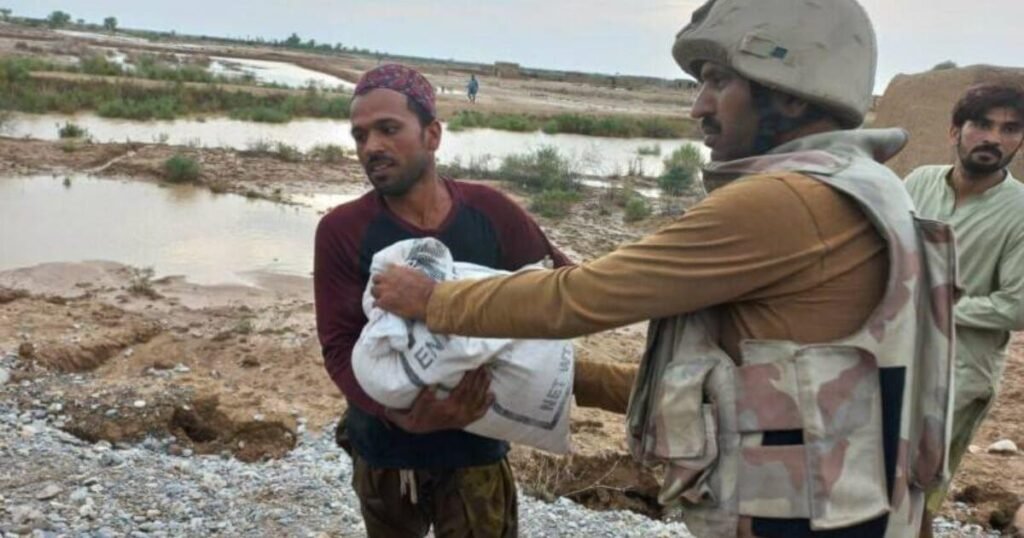The Punjab floods 2025 have created one of the most serious emergencies the province has faced in years. Weeks of monsoon rains Pakistan 2025 combined with sudden India water discharge Pakistan from the Thein Dam overflow and Madhopur Dam water release have pushed rivers beyond safe limits. Thousands of families are at risk as Ravi River flooding, Sutlej River high water levels, and the Chenab River flood risk threaten both farmland and residential areas. The Punjab government has called in the Pakistan Army flood relief teams to prevent further tragedy.
The NDMA flood alert and PDMA Punjab flood warning describe the next 48 hours as critical. Emergency relief Punjab is already underway with shelters, medical units, and Rescue 1122 operations across affected regions. Yet the scale of destruction continues to grow. From Narowal flood emergency to Sialkot floods, the situation demands immediate action.
Rising Waters: Punjab Faces Flood Catastrophe
The floodwaters in Punjab surged after India-Pakistan water tensions resurfaced when dams released huge quantities of water. At Kot Nainan, nearly 250,000 cusecs poured into the Ravi River, leaving villages submerged. The situation recalls the 2014 flood comparison, when Punjab lost thousands of acres of farmland. Today, the devastation is spreading faster due to heavy rains and higher water discharge levels.
Agriculture has taken the hardest blow. Fields of wheat, rice, and sugarcane are underwater. Families dependent on farming are forced to abandon their homes. The Pakistan Meteorological Department (PMD) warned that more rainfall will continue in upper Punjab and Kashmir. These patterns suggest that floods may last for weeks rather than days, raising fears of food shortages and long-term damage.
Key Flood Figures – Punjab Floods 2025
| Location | Water Inflow (cusecs) | Status |
| Head Marala barrage | 900,000+ | Chenab River flood risk, critical |
| Sutlej River (Ganda Singh Wala) | 195,000 | Sutlej River high water levels |
| Ravi River (Kot Nainan) | 250,000 | Ravi River flooding, villages submerged |
| Evacuations Punjab | 174,000+ people | Shifted to shelters under emergency relief Punjab |
Military Called In Across Six Districts
The military deployment in Punjab covers six badly hit areas: Lahore, Kasur, Sialkot floods, Faisalabad affected areas, Narowal district, and Okara. Army engineers are strengthening embankments while army aviation units prepare for aerial rescues. This swift Pakistan Army flood relief response shows the seriousness of the threat.
The Punjab government coordinated with the NDMA (National Disaster Management Authority) to make sure no time was wasted. Rescue 1122 and police forces are already assisting, but the volume of floodwater requires military-level logistics. Bridges, boats, and helicopters are now being used for transportation of stranded families.
Evacuations: Over 174,000 People Moved to Safety
Authorities confirmed that more than 174,000 people have followed evacuation orders Punjab floods and shifted to safer zones. Relief camps in Narowal district and Kasur flood risk zones provide food, clean water, and medicines. The emergency relief Punjab efforts are led by both civilian and military teams.
Families share stories of survival. Children separated during chaos were reunited at shelters. Many people were carried to boats by volunteers. Still, countless homes remain underwater. The government urges everyone to follow instructions, as the situation could worsen with more monsoon flooding Pakistan.
Alarm on River Levels and Inflows
The Chenab River flood risk is at its peak. At the Head Marala barrage, inflows reached over 900,000 cusecs. This level mirrors the 2014 flood comparison that devastated central Punjab. Downstream towns face immediate danger as embankments strain under massive pressure.
The Sutlej River also records high inflows at Ganda Singh Wala with 195,000 cusecs. As both Sutlej River high water levels and Ravi River flooding continue, localities in Faisalabad affected areas and Kasur flood risk zones are preparing for possible mass evacuations. Officials confirm that rising waters may breach current flood defenses if rain continues.
Local Rescue Teams Already on the Ground
Even before the army arrived, Rescue 1122 operations began in flood-hit towns. Teams used boats, ropes, and pumping equipment to pull people out of submerged homes. Volunteers distributed rations, and civil defence teams cleared blocked roads. These emergency relief Punjab actions saved many lives.
Still, demand is overwhelming. More calls come in than resources available. Some teams are forced to work day and night in shifts. Dr Usman Anwar (Punjab IGP) ordered police to secure relief camps, ensuring safety for flood-affected families and their belongings.
Government Monitoring 24/7

The PDMA (Provincial Disaster Management Authority) and NDMA flood alert centers now operate round the clock. Satellite images track water levels at the Ravi River, Sutlej River, and Chenab River. According to Irfan Ali Kathia (PDMA official), the next two days will determine how severe the disaster becomes.
Section 144 imposed in Punjab restricts unnecessary movement near embankments. At the same time, school closures due to floods have been declared in Sialkot floods regions to keep children safe. Emergency hotlines remain open to guide families on evacuation routes.
Ahsan Iqbal Visits Narowal
The Narowal flood emergency drew national attention when Ahsan Iqbal (Planning Minister) reached the district. He met with local administrators, army officers, and flood victims. His visit symbolized government commitment to act quickly.
Speaking to media, he urged citizens to stay cautious. “The administration is on the ground, but the scale of water demands army support,” he said. His words reminded everyone of how cooperation between citizens and institutions can reduce losses.
Climate Change Amplifies Flood Frequency
The Punjab floods 2025 are not just a natural accident. Scientists argue that climate change is making monsoon cycles more unpredictable. Monsoon rains Pakistan 2025 have been heavier than average, and melting glaciers in the north add more water to rivers like the Chenab River.
The NDMA (National Disaster Management Authority) predicts that rainfall intensity could rise by 20 to 25 percent in coming years. This means that without new dams, flood barriers, and water management systems, Punjab will face even worse disasters. Long-term plans must focus on resilience, not just relief.
Frequently Asked Questions (FAQs)
Why has the Punjab government called the Army for flood relief?
The Punjab government requested military deployment in Punjab as floodwaters reached critical levels, needing Pakistan Army flood relief support.
Which rivers are causing the worst flooding in Punjab?
The Sutlej River, Ravi River, and Chenab River are overflowing, increasing flood risks in Kasur, Narowal, and Sialkot floods zones.
How many people have been evacuated during Punjab floods 2025?
Over 174,000 people have been shifted to safe areas after evacuation orders Punjab floods were enforced by Rescue 1122 operations.
What areas are under the highest flood risk in Punjab?
The Narowal district, Faisalabad affected areas, and Kot Nainan face major threats due to Head Marala barrage inflows and river surges.
Did India release water into Pakistan during these floods?
Yes, India-Pakistan water tensions rose as Madhopur Dam water release and Thein Dam overflow worsened flooding inside Pakistan.
What actions are taken by NDMA and PDMA in this crisis?
The NDMA flood alert and PDMA Punjab flood warning are active, with Dr Usman Anwar and Irfan Ali Kathia leading operations.
Conclusion
The Punjab floods 2025 have pushed the province into crisis, forcing the Punjab government to request military deployment in Punjab. With Pakistan Army flood relief, Rescue 1122 operations, and continuous monitoring by the PDMA Punjab flood warning and NDMA flood alert, lives are being saved every hour.
But the future demands stronger preparation. From India-Pakistan water tensions to climate change, multiple factors now threaten Punjab. Only collective awareness, better planning, and long-term investment in infrastructure can protect families from another devastating flood like this one.








